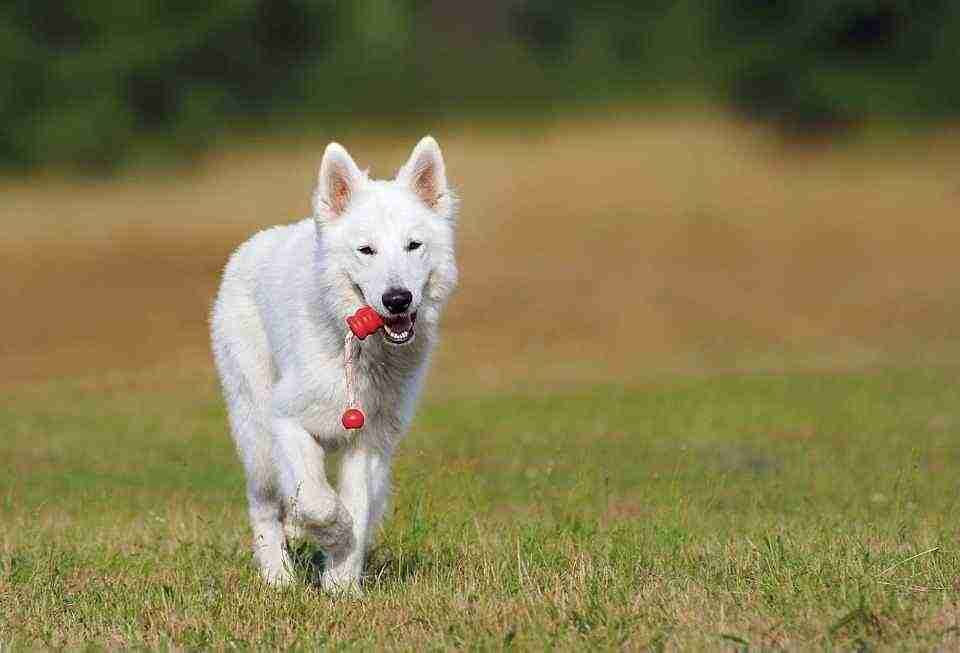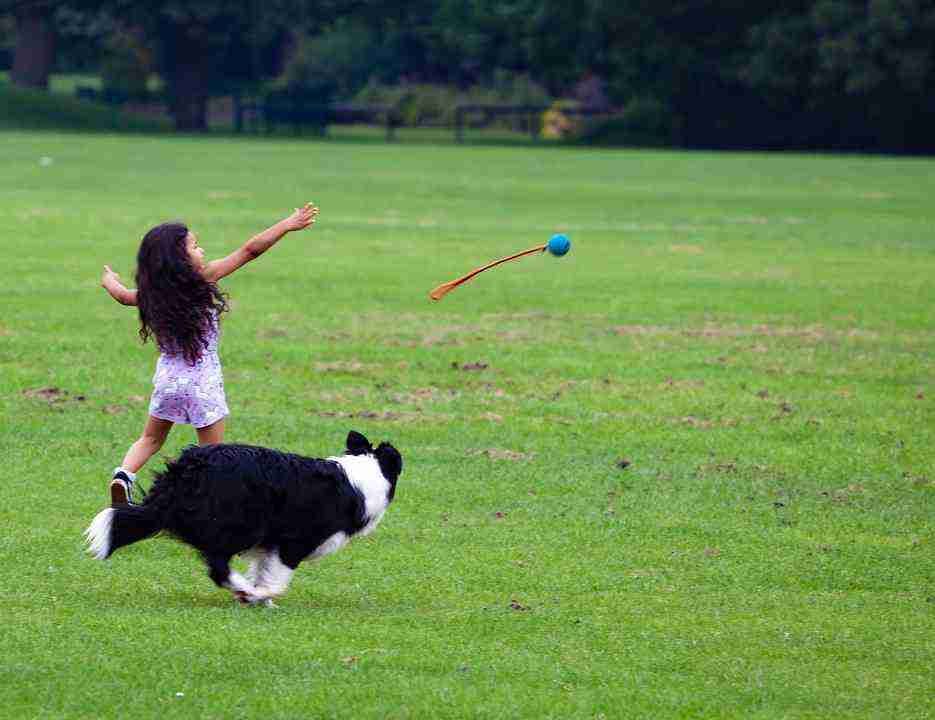All dogs can benefit from interactive pet toys. These fun devices teach new skills, provide fun experiences, and encourage your dog to think in new ways. Whether your pup is bored, restless, or simply a little disengaged, an interactive toy will catch their interest and teach them something new.
What Are Interactive Dog Toys?
A classic example of a normal dog toy is a piece of rope. It has a great texture and is easy for your dog to move on their own. They can chew it, throw it, and play tug of war with their favorite human.

An interactive dog toy asks your dog to solve a puzzle. A simple interactive toy might be a tennis ball strung on a rope. If the dog can remove the tennis ball, he gets to keep it as a reward.
Interactive dog toys come in many different styles and difficulty levels. Some toys are complicated; the dog may have to move several pieces to receive a treat as a reward. Simpler designs may involve small plush toys hidden within a larger toy. When the dog starts his normal chewing behavior, he will quickly discover several fun surprises waiting for him.
There are many great reasons to get your dog an interactive toy, but the most important one is fun. These toys are unique, interesting, and designed to keep your dog’s attention for hours on end.
The Link Between Boredom and Misbehavior
Dogs are good. They try so hard to do what you want and contribute to the family. So why does an angelic canine still get into the trash when you go out for the day?
The answer is boredom. Dogs are full of energy and excitement. They want to jump, play, learn, and experience. They especially want their owner’s attention. If a dog is misbehaving, it probably means that he’s bored or understimulated.
A dog will usually come to their owner first when they are bored. But if the owner is busy or out of the house, the dog will find ways to alleviate that boredom on their own. Those solutions might include destroying a shoe, barking endlessly at the neighbors, or digging a hole under the back fence. Some actions, like barking, force the owner to come and pay attention to the dog; from the pup’s point of view, this is an absolute win.
Stimulating Activity
You don’t need to wait until your dog is bored out of his mind to give him a stimulating activity. Even the most well-behaved pups will appreciate toys that keep them entertained.
Many dog toys, like tennis balls, actually require the owner’s participation. Ropes and rubber bones are meant for chewing; these toys make great solo activities, but any single toy will get boring after a while. Plush toys are meant for snuggling, but an understimulated dog will probably destroy them when she has nothing else to do.
Interactive dog toys are designed to provide additional stimulation and excitement. Many of these toys can be used while the dog is bored and alone. As the owner, you’ll simply need to refill or reset the toy once in a while.
No matter what kind of toys your dog likes, remember to buy new ones on a consistent basis. All living creatures get bored of items and activities that have no variation. Your dog should have multiple kinds of toys to choose from when they feel bored. Replace toys when they break or get a new one as a fun surprise.
Encouraging Your Dog to Be More Intelligent
Boredom aside, interactive pet toys help your dog engage with their environment. Interesting and stimulating toys will help both young puppies and old dogs learn new ways to think and use their senses.
Dog toy designers approach the world from your pup’s point of view. They need to understand how dogs think and use that information to engage and encourage your dog’s interests.
Dogs interact with their environment through their senses. Smell and sound are extremely relevant to dogs. Next, taste and texture hold high levels of importance. Dogs use sight to varying degrees; sight is not as important to dogs as it is to humans, but some dogs react very strongly to shape and color.
Muzzle Memory
Dogs use their muzzles to eat delicious food, investigate smells, and pick up toys. Dogs can also use their paws to nudge items, hold things down, and shake hands with their humans.
Good interactive toys are designed with this information in mind. Toys that have interesting textures, contain treats, or make fun sounds will immediately grab a pup’s attention. Toys that encourage dogs to use their muzzles or paws in new ways will increase their finesse and provide mental stimulation.
An interactive toy makes your dog think outside of the box. It uses the things a dog finds interesting to get them to try something new. The toy might ask your dog to find a treat, discover a smaller toy, or free a tennis ball from a seemingly unsolvable puzzle.
Solving these toys will help your dog learn to use the tools available to them. Most of the toys feature a reward; whether it’s a treat or a smaller toy, your dog will feel a huge confidence boost when they solve the puzzle. The more interactive toys your dog solves, the more confident and intelligent they will feel.
Interactive toys are great for dogs of any age, but they can be especially effective when given to puppies. Learning to interact with these toys will encourage your dog to approach situations with a problem-solving mentality. This can make communication and training easier later on.
Choosing an Interactive Toy for Your Dog
An interactive dog toy usually takes the form of a puzzle that your dog can solve. Most interactive toys fall into two categories: those with treat rewards and those with toy rewards.
Treat reward toys come in many different forms. A Kong is a classic treat reward toy with a simple premise: food is in the center of the toy, and the dog needs to work to get it out.
Another style of treat reward toy is a food dispenser. These toys look like large plastic balls, dishes, or cones. When the toy is rolled, rocked, or flipped, treats fall out of a small hole. Dispenser toys are a great way to get your dog used to the concept of interactive toys. They can also be used to slow down a dog who eats too quickly.
Casino-style toys hide treats behind more complicated puzzles. Nina Ottoson is famous for her innovative dog toys; with these devices, dogs may need to remove pieces, press levers, or open drawers to reveal the treat.
Many different interactive dog puzzles exist on the market. Start your dog with something easy and work them up to more complicated puzzles and devices. Choose toys suited to your dog’s size; a puzzle meant for little dogs might be too delicate for large paws.
Don’t forget to consider your pet’s health. Treat toys are fun, but they shouldn’t impact your dog’s diet. You can substitute kibble in most of these toys as a healthier option.
Toy Rewards
Toy rewards are usually hidden within a larger toy. The famous Hide-a-Squirrel toy is shaped like a large tree trunk; tiny, squeaky squirrels are hidden inside. These toys are perfect for dogs who tend to destroy their plush toys looking for squeakers. Interactive plush toys reward their curiosity, and the small plushies are usually refillable.
Velcro is often used to hold interactive plush toys together. A toy might look like one plushie but pull apart to reveal that it’s actually two. Look for puzzle toys shaped like animals, pieces of fruit, or other clever designs.
Puzzels
Another toy-based puzzle involves a tennis ball hidden inside of a rubber cube. The material is flexible, so a clever dog will quickly be able to retrieve the tennis ball from the provided space. Look for variations on this design that suit the way your dog likes to interact. Remember that very small pieces can be choking hazards for larger dogs.
Other puzzle toys feature rings stacked on a pole or rubber items strung on ropes. Look for toys that your dog needs to use ingenuity to interact with. If he successfully removes the rubber ring, reward him by throwing it across the room.
You will find many hidden surprises in modern dog toys. When destroyed, some plushies reveal rubber squeakers or smaller plushies with a variant design. These toys reward dogs for the behaviors they naturally engage in.
Conclusion
Smart dogs will solve interactive toys very quickly. This doesn’t mean the toy was a failure; reward your dog for their ingenuity and put the toy back together again.
Even if they are not labeled as interactive, shop for dog toys that follow these principles of engagement. Look for moving pieces, fun textures, and interesting sounds. Pay attention to the toys your dog has the most fun with and buy other toys with similar features. If your pup has plenty to do, they won’t be so tempted to get into the trash.
Last Updated on 16/03/2025 by Karen Snow
Hi! I’m Karen and a certified dog lover. As a freelance writer and blogger, I do my best to squeeze in some time with my dogs, learning more about the way they act and how I can make sure that they continue to stay well-cared for by yours truly.
My dogs have helped me through a lot, and this is my way of giving back to them! Besides animals, I also love to travel and cook, having explored my country’s restaurants and unique places. Follow me as I show you all the amazing tips and bits of information I learn along the way about our furry friends!
